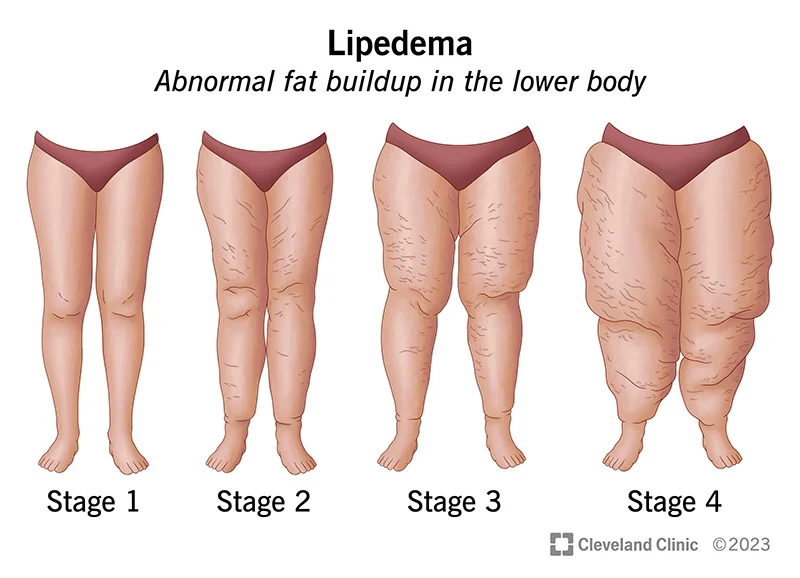Welcome to the second of our three-part series on various types of swelling in the body. The first up was edema, and today we are talking about LIPEDEMA.
While edema is an excess buildup of fluid in the body (potentially from injuries, recovering from surgery, or simply not enough movement), lipedema is a buildup of fat and water in the tissues, and it’s something that is often misdiagnosed because it only affects approximately 11% of women.
Lipedema is characterized by an abnormal accumulation of fat cells in specific areas of the body, typically the legs and buttocks, but sometimes also affecting the arms. This fat distribution is often uneven and disproportionate, leading to a pear-shaped or column-like appearance. Unlike obesity, which affects the entire body, lipedema tends to spare the feet and hands, creating a distinct pattern of swelling.

Symptoms of Lipedema
- Enlarged, Disproportionate Fat Deposits: The hallmark of lipedema is the disproportionate fat accumulation in the affected areas. This fat is often resistant to diet and exercise.
- Tenderness and Pain: Individuals with lipedema might experience pain and tenderness in the affected areas, especially when touched or bumped.
- Bruising: Lipedema-prone areas are prone to bruising due to the fragility of blood vessels under the skin.
- Swelling and Edema: Swelling can occur, particularly after prolonged periods of standing or sitting.
- Easy Bruising: The skin may be more susceptible to bruising and exhibit a spongy texture.
- Cellulite-Like Appearance: Lipedema can lead to a lumpy, cellulite-like appearance on the skin’s surface.
While so much is still misunderstood about lipedema, and it can often be misdiagnosed as obesity or lymphedema, some of the causes may include:
- Genetics: There appears to be a genetic component with a higher likelihood if family members are affected.
- Hormonal Influence: Hormonal changes, such as those during puberty, pregnancy, and menopause, can trigger or worsen symptoms.
- Inflammation: Some researchers suggest that inflammation plays a role in the development of lipedema.
- Vascular and Lymphatic Factors: Disturbances in the lymphatic and vascular systems might contribute to fat accumulation and fluid accumulation in affected areas.
Treatment options
While receiving a lipedema diagnosis, it’s essential to understand that it’s not a death sentence. While it can cause some emotional and physical distress because society judges people so harshly based on their appearance, and thanks to social media, filters, and expensive injections, nips, and tucks, we are made to feel that we are somehow less because we’re not perfect, there are treatments for it.
- Compression garments and lifestyle modifications (the boring old diet and exercise route) may help to relieve some of the pain of lipedema (both physical and emotional/mental)
- Manual Lymphatic Drainage (MLD) is designed to improve the flow of the lymphatic system, reduce swelling, and encourage homeostasis within the body. Manual therapy techniques such as myofascial release and cupping may also be helpful.
- Surgical interventions such as tumescent or water-assisted liposuction.
Curious to know if you might have lipedema when you’ve been joking that your body really likes its adipose tissue. Take the quiz!
In Good Hands,
Rebecca Tamm, LMT, MLD-C